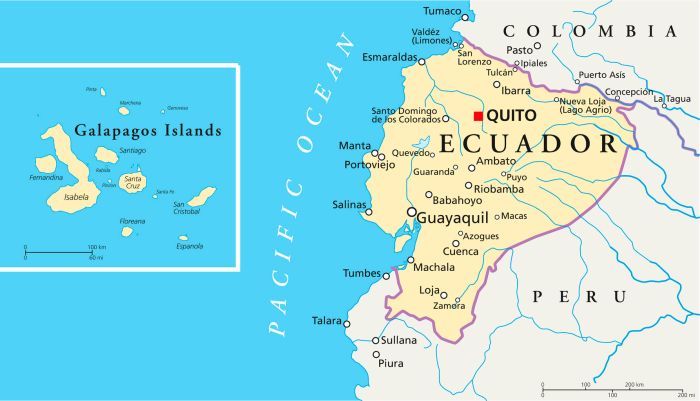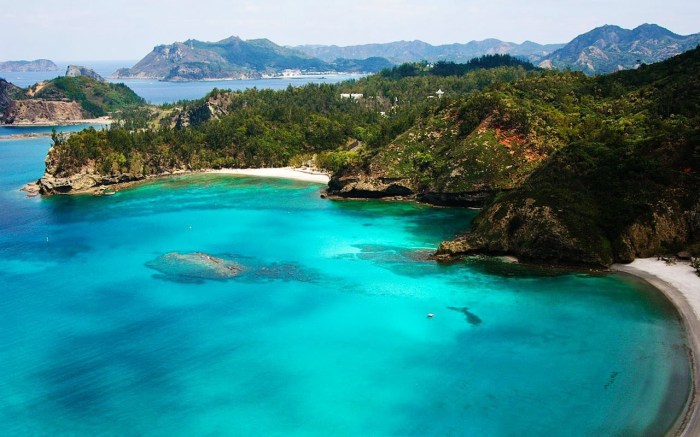Donde estan las islas galapagos – Embark on an extraordinary journey to the Galapagos Islands, a mesmerizing archipelago that lies where the Pacific Ocean meets the enigmatic shores of Ecuador. Prepare to be captivated by the islands’ awe-inspiring beauty, where volcanic origins and unique geological formations have shaped a sanctuary for unparalleled biodiversity.
From the majestic giant tortoises to the playful marine iguanas, the Galapagos Islands serve as a living laboratory for scientific research and conservation efforts. Immerse yourself in the islands’ rich history, vibrant culture, and sustainable tourism practices that aim to preserve this fragile paradise for generations to come.
Location
The Galapagos Islands are a group of volcanic islands located in the Pacific Ocean, about 970 kilometers (600 miles) west of the coast of Ecuador. The islands are part of the Republic of Ecuador and are considered a province of the country.
The Galapagos Islands are located at the confluence of three major ocean currents: the Humboldt Current, the Cromwell Current, and the Panama Current. These currents bring nutrient-rich waters to the islands, which support a diverse marine ecosystem.
Proximity to the Mainland
The Galapagos Islands are located about 970 kilometers (600 miles) west of the coast of Ecuador. The islands are not visible from the mainland, but they can be reached by boat or plane.
Proximity to the Pacific Ocean
The Galapagos Islands are located in the Pacific Ocean, about 1,000 kilometers (620 miles) from the coast of South America. The islands are surrounded by the Pacific Ocean, and they are not connected to any other landmass.
Formation
The Galapagos Islands, an archipelago of volcanic origin, were formed through the combined forces of volcanic activity and plate tectonics. They are located on the Nazca Plate, which is slowly moving eastward and subducting beneath the South American Plate. As the Nazca Plate descends, it melts due to the intense heat and pressure, and the molten rock rises to the surface, forming volcanoes.
The Galapagos Islands are part of a hotspot, which is a weak spot in the Earth’s crust where magma from the mantle can rise to the surface. The hotspot has been active for millions of years, and has produced a chain of volcanoes that make up the islands.
The oldest islands are in the east, and the youngest are in the west.
Unique Geological Features
The Galapagos Islands are characterized by a number of unique geological features, including:
- Volcanic landscapes:The islands are covered in volcanic rock, and there are many active and dormant volcanoes. The landscape is rugged and barren, with few trees or plants.
- Lava tubes:Lava tubes are formed when lava flows through a tunnel and then cools and hardens. The Galapagos Islands have many lava tubes, some of which are large enough to walk through.
- Craters:Craters are formed when a volcano erupts and collapses. The Galapagos Islands have many craters, some of which are filled with water.
- Calderas:Calderas are large, collapsed craters. The Galapagos Islands have several calderas, including the caldera of Fernandina Island, which is one of the largest calderas in the world.
Archipelago
The Galapagos Islands are an archipelago located in the Pacific Ocean, about 600 miles west of mainland Ecuador. The archipelago consists of 13 major islands, 6 smaller islands, and 107 islets, covering a total land area of approximately 7,880 square kilometers (3,040 square miles).
The islands are distributed over an area of approximately 45,000 square kilometers (17,000 square miles).
Major Islands, Donde estan las islas galapagos
The major islands of the Galapagos archipelago are:
- Isabela Island:The largest island in the archipelago, with an area of 4,640 square kilometers (1,790 square miles).
- Santa Cruz Island:The second largest island, with an area of 986 square kilometers (381 square miles) and the most populous island in the archipelago.
- Fernandina Island:The third largest island, with an area of 642 square kilometers (248 square miles).
- San Salvador Island:The fourth largest island, with an area of 585 square kilometers (226 square miles).
- Santa Maria Island:The fifth largest island, with an area of 171 square kilometers (66 square miles).
- Floreana Island:The sixth largest island, with an area of 172 square kilometers (66 square miles).
- Genovesa Island:The seventh largest island, with an area of 14 square kilometers (5.4 square miles).
- Marchena Island:The eighth largest island, with an area of 13 square kilometers (5.0 square miles).
- Pinzon Island:The ninth largest island, with an area of 18 square kilometers (7.0 square miles).
- Santa Fe Island:The tenth largest island, with an area of 24 square kilometers (9.3 square miles).
- Santiago Island:The eleventh largest island, with an area of 585 square kilometers (226 square miles).
- Rábida Island:The twelfth largest island, with an area of 4.9 square kilometers (1.9 square miles).
- Bartolomé Island:The thirteenth largest island, with an area of 1.2 square kilometers (0.46 square miles).
Climate

The Galapagos Islands are known for their unique climatic conditions, shaped by the interplay of ocean currents and prevailing winds.
The islands are located in the path of the cold Humboldt Current, which brings cool, nutrient-rich waters from the south. This current helps to moderate temperatures and supports a diverse marine ecosystem. The islands are also influenced by the warm Panama Current, which brings warmer waters from the north.
The combination of these two currents creates a unique microclimate that is characterized by relatively stable temperatures and low humidity.
Average Temperatures
Average temperatures in the Galapagos Islands range from 22°C to 28°C (72°F to 82°F) throughout the year. The warmest months are January and February, while the coolest months are July and August.
Rainfall
Rainfall in the Galapagos Islands is highly variable, with the wet season lasting from December to May and the dry season from June to November. The average annual rainfall is around 700 mm (28 inches), but there can be significant variation from year to year.
Humidity
Humidity in the Galapagos Islands is generally low, averaging around 60%. However, humidity levels can vary significantly depending on the time of year and the location on the islands.
Flora and Fauna

The Galapagos Islands boast an extraordinary diversity of plant and animal life, making them a living laboratory for scientific research and conservation efforts.
Endemic Species
The islands are home to numerous endemic species found nowhere else on Earth. Among the most iconic are the giant tortoises, which can live for over 100 years and weigh up to 400 pounds. Marine iguanas, the only sea-going lizards, are another unique species found on the Galapagos.
They can dive to depths of up to 30 feet to feed on algae.
Natural Laboratory
The Galapagos Islands have been instrumental in the development of evolutionary theory. Charles Darwin’s observations of the archipelago’s unique flora and fauna led to his groundbreaking theory of natural selection. Today, the islands continue to be a vital site for scientific research, helping us understand the processes that shape life on Earth.
Human Presence
The Galapagos Islands have a fascinating history of human settlement and exploration. The islands were first discovered by Spanish explorers in the 16th century, but it was not until the 19th century that permanent settlements were established. The islands’ unique ecosystem and abundant wildlife attracted scientists and naturalists from around the world, including Charles Darwin, whose observations on the islands’ finches helped to shape his theory of evolution by natural selection.
Impact of Human Activities
Human activities have had a significant impact on the Galapagos Islands’ ecosystem. The introduction of non-native species, such as goats and rats, has led to the decline of native species. Overfishing and tourism have also put a strain on the islands’ resources.
In response to these threats, the Galapagos National Park was established in 1959 to protect the islands’ fragile environment.
Current Population and Economic Activities
The current population of the Galapagos Islands is approximately 30,000 people. The majority of the population lives on the island of Santa Cruz, which is also home to the capital city of Puerto Ayora. The economy of the Galapagos Islands is based on tourism and fishing.
The islands are a popular destination for ecotourists who come to see the unique wildlife and scenery.
If you’re curious about where the Galapagos Islands are, you might also be interested in learning about spider bites in dogs. While the islands are known for their unique wildlife, it’s important to be aware of potential hazards like spider bites . The Galapagos Islands are a beautiful destination, but it’s always wise to take precautions to ensure the safety of your furry companions.
Tourism: Donde Estan Las Islas Galapagos

The Galapagos Islands have become a renowned tourist destination, attracting nature enthusiasts and wildlife photographers from around the world. The unique ecosystem and abundant wildlife offer an unforgettable experience for those seeking to immerse themselves in the wonders of the natural world.
The archipelago’s diverse landscapes, from volcanic peaks to pristine beaches, provide a stunning backdrop for wildlife encounters. Visitors can observe iconic species such as giant tortoises, marine iguanas, sea lions, and a vast array of birdlife, including the famous blue-footed boobies and waved albatrosses.
Sustainable Tourism Practices
To preserve the delicate ecosystem of the Galapagos Islands, sustainable tourism practices have been implemented. Regulations limit the number of visitors and require tour operators to adhere to strict guidelines. These measures include:
- Restricted access to sensitive areas to minimize disturbance to wildlife.
- Mandatory use of certified tour guides to ensure responsible conduct.
- Education programs to promote awareness and respect for the environment.
- Strict regulations on waste disposal and water conservation.
By adhering to these regulations, visitors can contribute to the conservation efforts and ensure that future generations can continue to enjoy the pristine beauty of the Galapagos Islands.
Conservation

The Galapagos Islands’ unique biodiversity faces various threats, including invasive species, habitat destruction, and climate change. Conservation efforts are crucial to protect and preserve this fragile ecosystem.
National parks and marine reserves play a vital role in safeguarding the islands’ biodiversity. They establish protected areas where human activities are restricted, allowing native species to thrive. The Galapagos National Park, established in 1959, covers 97% of the land area and includes a variety of habitats, from arid lowlands to lush highlands.
Research and Monitoring Programs
Ongoing research and monitoring programs contribute significantly to conservation efforts. Scientists study the islands’ flora and fauna to assess their status, identify threats, and develop conservation strategies. Monitoring programs track changes in species populations, habitat quality, and environmental conditions, providing valuable data for decision-making.
For example, the Galapagos Tortoise Movement Ecology Program uses GPS tracking to monitor the movements and behavior of giant tortoises, providing insights into their habitat use and threats they face.
FAQ Explained
How far are the Galapagos Islands from Ecuador?
The Galapagos Islands are located approximately 600 miles (965 kilometers) west of mainland Ecuador.
What is the best time to visit the Galapagos Islands?
The best time to visit the Galapagos Islands is during the dry season, which runs from June to December. During this time, the weather is generally clear and sunny, with calmer seas.
Are the Galapagos Islands expensive to visit?
Yes, the Galapagos Islands can be expensive to visit due to the limited number of visitors allowed and the high cost of transportation and accommodation.